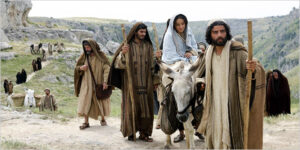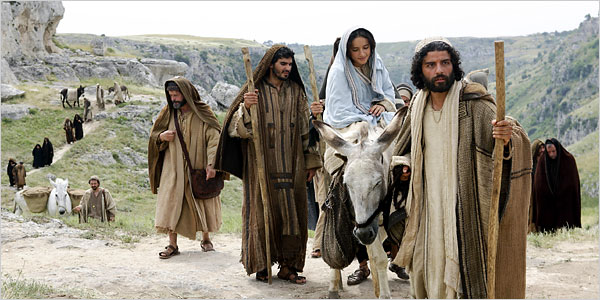Movie Info
Movie Info
- Director
- Adam Anders
- Run Time
- 1 hour and 38 minutes
- Rating
- PG
VP Content Ratings
- Violence
- 2/10
- Language
- 1/10
- Sex & Nudity
- 1/10
- Star Rating
Relevant Quotes
In those days a decree went out from Caesar Augustus that all the world should be registered…
Joseph also went from the town of Nazareth in Galilee to Judea, to the city of David called Bethlehem, because he was descended from the house and family of David.

Director/co-writer Adam Anders and writer Peter Barsocchini have served up an interesting Nativity Story by combining the Gospel accounts—indeed, squishing them together, as I’ll explain later—of Christ’s birth in Luke and Matthew and then adding to them a lot of fanciful material that includes singing and dancing. The result is a flawed but entertaining addition to the Jesus Film genre that will be of interest to fans of faith-based films and maybe of interest to others who like musicals. Also, to fans of actor Antonio Banderas—a real coup in securing him for the role of King Herod.
There are a lot of quick jumps back and forth in time and space– between the Magi, Mary and Joseph, and King Herod, and his ambitious son Antipator (Joel Smallbone). The theme of power-seeking, and its corrupting influence, is set forth immediately with the early appearance of Herod in the film as he sings “It’s Good to be King.” East of Judea we re introduced to the three Magi, who have more in common with the Three Stooges than the dignified scholars of tradition. One of them is so amusingly short that he has to lifted up to align his eye with the astronomical instrument used by the other to spot the Star, and the third seems to be a gastronome, as interested in good food as in the Star. At one point they sing “Three Wise Guys.” Daniela Riveri as “the Magi’s servant girl” travels with them, at the beginning of their trip singing “O Come, O Come Emmanuel,” and on the night of the Birth, “Silent Night.”
Fiona Palomo’s youthful beauty is well suited for her role as Mary, who is imagined as the middle sister of Deborah and Rebekah, but she is not the meek, submissive virgin of tradition. When her parents announce her betrothal to Joseph (Milo Manheim), son of a Bethlehem family whom she has never met, she is upset, declaring that she wants to marry for love. In the marketplace she sings and dances with her two sisters and townspeople “Mary’s Getting Married.” Then she meets Joseph cute in the market, neither of them recognizing the other until they see each other again at the betrothal ceremony—which is staged beautifully. Mary and Joseph sing “Can We Make This Work” as they share their doubts and hopes. Near the end of it they sing “Our future holds more than we can see/We have to rust when we don’t understand/It could be part of God’s plan…”
The angel Gabriel comes to Mary one night—played at first for laughs, Gabriel trying out various lines with which to begin his unusual announcement, and then, because he is so tall, hitting his head on the doorway. Mary, of course, is troubled by the announcement that she is pregnant as she talks with her family. Joseph is even more so, his parents returning to Bethlehem with the wedding called off. He wants to believe Mary, but her story is too unbelievable. She is sent away to her cousin Elizabet her, an older woman who also has just conceived a son and her husband struck dumb. Meanwhile Joseph, torn between love and disbelief, sings the powerful song “The Ultimate Deception,” which movingly expresses his dilemma, until he ultimately decides to believe her outlandish story and rushes off to find her.
Herod is also troubled by the news brought by the Magi that “a new king” is to be born within his borders. He sends out Antipater to find and eliminate the mother and child. Mary and Joseph’s actual journey to Bethlehem takes just a small portion of the running time, with the pair barely eluding Antipas and his soldiers. There is some silly business of them discovering Bethlehem surrounded by soldiers so that they have to sneak into town via a secret tunnel. The failure to find a room in the inns, the birth in the stable with a large chorus of angels singing and bringing both the shepherds and the Magi to the crib at the same time—hence my early phrase “squished together—goes by so fast. No separating Christmas from Epiphany, as per the gospel of Matthew, in this film. And then the injection of a totally invented episode involving Antipas, and Mary, Joseph, and the donkey (whom child viewers will enjoy because of what it does) are leaving town, heading for Egypt, and “The End” brings everything to a close.
At first, I felt that the injection of Herod’s oldest son Antipater into the gospel story was unwelcome —especially when he becomes central to their escaping Herod’s wrath, but when I went back and listened to his soliloquy in the forboding song “It’s In My Blood,” I changed my mind. With his younger self standing before him at times, Antipater muses how he had once looked up to his father and followed in his cruel and violent ways. He wonders about his future, whether he is stuck in darkness because “it’s in my blood.” A powerful statement of being doomed to repeat his father’s dark deeds. If you know about his father—how King Herod was always suspicious of other’s usurping his power that he killed any suspected rival, including some of his own sons and his favorite wife Mariamne—this adds to the power of the film. And to the need of our world for the Nativity.
I don’t know if we are witnessing the birth of a Christmas classic, but have no doubt that this is a unique depiction of the Nativity Story. A more appropriate title would have been Mary and Joseph, because the turmoil surrounding the journey eclipses the brief sequence of the trip itself. Though undergird by violence, this is depicted in such a way that families with young children can enjoy it together. As mentioned earlier, children will be drawn to the donkey. It has a mind of its own and contributes to the story at a couple of important stages.
This is a first-rate production. The cast is uniformly convincing, with the chemistry between the talented actor/singers Fiona Palomo and Milo Manheim excellent. Antonio Banderas obviously is enjoying his role as the power-mad tyrant and Joel Smallbone evokes our sympathy as the hapless son infected by the blood of his vicious father. The costumes are gorgeous, and the staging of the dances is a delight.
The songs are not add-ons, but integral to our experiencing the doubts, confusion, and anguish of the characters. They truly move the story along. I suspect we will hear more about them in the upcoming Oscar season— especially “Can We Make this Work,” because it has been released as a single recording. Also, there is an achingly haunting quality to the song that Mary sings as she is being sent away from Bethlehem, “Mother to a Savior and a King.” It is a heartfelt prayer, the line “Give me eyes to see how I can be carrying your Son when I need You to carry me” being very memorable.
Although mid-November seems a bit early, this is a film worth seeing while it is playing in theaters. Thre are so many scenes, especially the dance sequences, that are best seen on a big screen. I do wish that the birth and the visit of the Magi were not squished together (thus reinforcing the false impression given by church bathrobe pageants) and that the script writers had not injected so many incidents that they thought necessary to jazz up the original gospel stories in Matthew and Luke. Nonetheless, there are so many good elements to this film that I recommend it—and look forward to watching it again. People of faith would do well to form a viewing group to discuss it after going together to see it. It certainly undergirds the famous slogan, “Jesus is the reason for the Season.”
This review will be in the December issue of VP along with a set of questions for reflection and/or discussion. If you have found reviews on this site helpful, please consider purchasing a subscription or individual issue in The Store.

